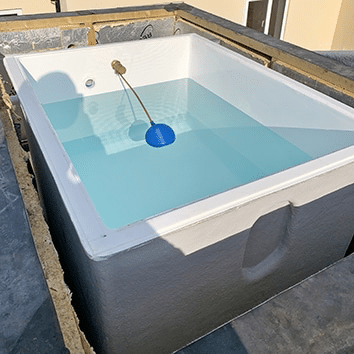Water Tank Cleaning and Chlorination
When it comes to preventing contamination, Water Tank Cleaning and Chlorination is an essential processes, especially when it comes to preventing Legionella.
We have engineers who are experienced and trained in undertaking all aspects of Water Tank Cleaning and Chlorination, ensuring we are available to undertake regular cleaning using a range of methods which includes direct injection and gravity-fed chlorination.
GALLERY



What Does the Water Tank Cleaning and Chlorination Process Involve?
The tank will be emptied using a submersible pump which is a standard method and then we carry out the Water Tank Cleaning and Chlorination process using an industrial wet vacuum before carrying out a complete clean whereby we utilise disinfectant solutions to help with the cleaning process.
We then refill the tank before adding sodium hypochlorite to a level of 50ppm. We then open the required taps and valves to run the solution through the system. After an hour, the Water Tank Cleaning and Chlorination process is complete.
We take a sample of water to carry out the required checks to ensure that chlorine levels are right and if not, we carry out the process again. We then drain the tank again and refill it using freshwater which is then flushed through the system to help remove all remaining chlorine.
Get in touch today to learn more about our Water Tank Cleaning and Chlorination services.


Water Tank Cleaning and Chlorination of Water Mains
We use a mobile tank and dosing pump to carry out closed system chlorination which includes the likes of water mains. We add a 50ppm sodium hypochlorite solution to the tank then connect it to the existing or newly installed water main.
The chlorine solution is then injected into the water main making sure that we open all outlets in sequence while ensuring the furthest outlet is opened.
We then test the discharge from all draw-off points until we identify a solution with a minimum of 50ppm. We then leave the system for an hour before testing several draw-off points.
If we are satisfied, we then remove the mobile tank and dosing pump before we flush the system with mains water while checking that chlorine is completely removed.
The process is carried out using a range of chemicals which include chlorine as this is highly effective at preventing Legionella and biofilms.
We can also save large volumes of water and costs by neutralising water chlorination chemicals where required.
Why it is Important to carry out Water Tank Cleaning and Chlorination to your supply or mains?
When it comes to your water main or supply, hygiene is vital and that’s why we offer a range of water chlorination methods such as direct injection and gravity-fed.
We also have the scope to offer our Water Tank Cleaning and Chlorination service across a range of settings, ensuring you can benefit from our service and having the ability to prove that you have had the necessary cleaning completed. We cover the following sectors:
Farms
Hospitals
Factories and process facilities
Commercial properties
Furthermore, it’s important that you have the necessary cleaning completed to ensure that you adhere to the Health and Safety Executive’s HSG274 guidelines and code of practice (ACOP L8). This states that tanks should be inspected a minimum of once per year or more if contamination is identified.

The Risks of Not carrying out Water Tank Cleaning and Chlorination
Stagnant water sources can become a breeding ground for harmful bacteria. It’s caused by a range of factors including under-utilising water, using a tank that is too large and blockages or reduced flow.
However, water tanks commonly experience some element of stagnation which means that regular cleaning and disinfection is crucial.
Cold water storage tanks are susceptible to biofilm and Legionella while rust, sediment and silt can develop over time.
Another risk is debris coming in from the mains which means that the tank can act as a catchment area, which means that debris can lead to the build-up of nutrients and bacteria.
